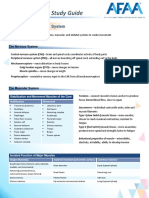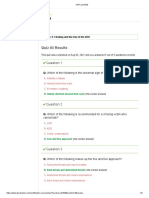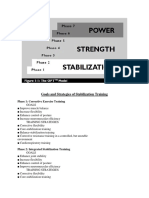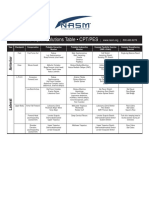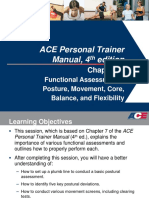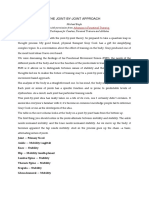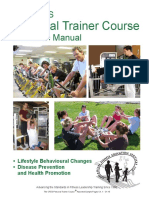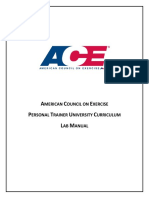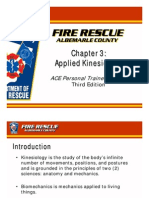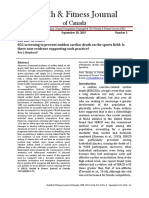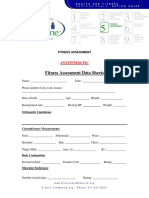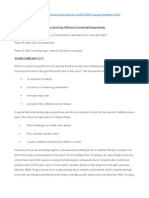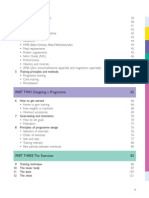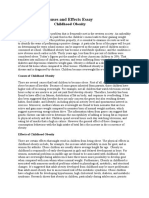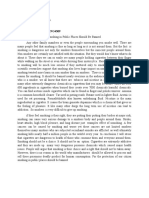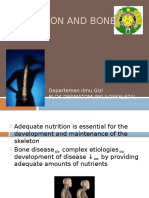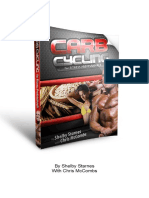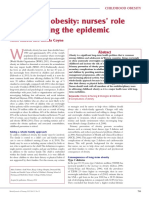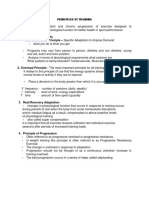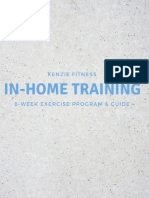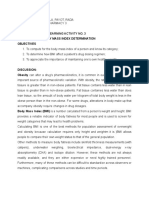CPT Study Guide, Version 4
On the actual exam, you will be tested in the following subject areas (exam breakdown):
Basic and Applied Sciences
15 Questions
Assessment
15 questions
Exercise Technique and Training Instruction
20 questions
Program Design
20 questions
Nutrition
12 questions
Client Relations Behavioral Coaching
10 questions
Professional Development, Practice and Responsibility
8 questions
National Academy of Sports Medicine Code of Ethics (In the beginning of your book)
Be sure to read all the sections as there will be test questions on this. You may see
something like how long should a personal trainer keep client records for? The correct
answer would 4 years. (Located under Business Practice)
Chapter 2 Basic Exercise Science
Know all definitions
Figure 2.34
Figure 2.38
Table 2.5 Muscle Fiber Types
Table 2.6 Muscle as Movers
Chapter 3 The Cardiorespiratory System:
Figure 3.3 Atria and Ventricles know the functions of the right and left atrium and the
right and left ventricles
Table 3.1 Support Mechanisms of Blood
Table 3.2 Structures of the respiratory pump.
Chapter 4 Exercise Metabolism and Bioenergetics:
Be Familiar with all definitions throughout the chapter
Chapter 5 Human Movement Science:
Know definitions throughout the chapter in detail.
Figure 5.3 Planes of Motion
Table 5.1 Examples of Planes, Motions, and Axes
The planes of motion can be a bit tricky, so here is a little bit of clarification:
Frontal Plane
NOT front to back movements
Side to side movements
Exercises involving abduction and/or adduction of the limbs
Example: side lunge, lateral dumbbell raise, ice skater
Imagine a wall in front and in back of you. The ONLY movement this would allow is along
that plane-sideways movements.
Sagittal Plane
Forward and backwards movements
Movements involving pushing and/or pulling
Movements involving flexion and/or extension at joints
Example: bicep curl, front lunge, bench press, and rows
Imagine a wall on your right and left side. The ONLY movement this would allow is along
that plane-or front and back movements.
Transverse Plane
Rotational movements
Diagonal movements
Example: rotation, wood-chop throw, medicine ball rotation chest pass
Figure 5.4 Joint Motions
Figure 5.5 Joint Motions
Figure 5.6 Joint Motions
Figure 5.7 Joint Motions
Table 5.2 Muscle Action Spectrum
Isotonic
o
Eccentric
Concentric
Isometric
Isokinetic
Table 5.3 Common force couples
Figure 5.15 Levers
Chapter 6 Fitness Assessment:
This is going to be a very important chapter to know as a lot of test question will be taken
from this chapter.
Table 6.1 Guidelines for Health and Fitness Professionals
Figure 6.1 Subjective vs. Objective information
Figure 6.2 Sample Physical Activity Readiness Questionnaire
Figure 6.3 Sample questions: client occupation
Figure 6.4 Sample questions: client lifestyle
Figure 6.5 Sample questions: client medical history
Table 6.2 Common medications by classification
Table 6.3 Effects of medication on heart rate and blood pressure
Heart rate and blood pressure assessments
Table 6.4 Target heart rate training zones
Max Heart Rate formula (straight percentage method) for each zone
Body Composition Assessments
Circumference measurements
Body Mass Index
YMCA 3-minute step test
Rockport Walk Test
Table 6.9 Pronation Distortion Syndrome
Table 6.10Lower Crossed Syndrome
Table 6.11Upper Crossed Syndrome
Be familiar with all of the assessment protocols and for the posture assessments all
compensations
Chapter 7 Flexibility Training Concepts:
Know all definitions throughout the chapter
Figure 7.10 Integrated flexibility Continuum
Table 7.2 Examples of stretching within the Flexibility Continuum
Myofascial Release
Table 7.3 Static Stretching Summary
Table 7.4 Active-Isolated Stretching summary
Table 7.5 Dynamic Stretching summary
Mechanoreceptors = a Golgi tendon organ (GTO) and muscle spindle fibers
�GTO
Muscle Spindle Fibers
Senses muscle tension
Senses muscle lengthening
Relaxes the muscle in response
Contracts the muscle in response
Normal reaction to avoid injury
Normal reaction to avoid injury
There is a lot of useful information in table 7.6 of the NASM Essentials of Personal Fitness
Training and it will take some time to remember all of that information. There are various
strategies you can try as you attempt to retain that information. One is to make your
studying interactive by asking friends and family members to volunteer for the Overhead
Squat Assessment and practice trying to locate compensations. Another way to learn the
probable overactive and probable underactive muscles is by creating flash cards.
You can also look at each overactive muscle and refer back to Appendix D (in the back of
the book). Look at each muscle's "Isolated Function". Some muscles will over-do their
"Isolated Function". Other muscles tend to be "victims of association". This means that they
may become synergistically dominant because a muscle nearby becomes
underactive/lengthened/weak.
In addition, by having a general idea of what each muscle's "Isolated Function" is, you will
be able to figure out exercises that directly work those muscles.
Think of muscles in terms of antagonistic (one is an agonist while the other is an antagonist)
actions. When an agonist contracts, the antagonist will relax. Also keep in mind that several
muscles may have similar actions and that the exact movement of a bone will be the result
of a coordinated effort involving many muscles (force couples). Muscles function in
integrated groups to allow for neuromuscular control during movement. A muscle's
integrated muscle function is the action it naturally tends to perform when it works in
conjunction with other muscles. By isolating each muscle on the other hand, and tracing
them from their point of origin to their insertion, one can gain a better understanding of that
muscle's main function. A muscle's isolated function is what that individual muscle is meant
to do, alone, and isolated from all other muscles.
An advanced knowledge in anatomy is required to identify muscle functions such as
agonists, antagonists, synergists, and stabilizers. For example, most stabilizers are
proximal to the joint they stabilize, but it is dependent on the movement that is occurring.
Stabilizers are generally smaller in size, made up of type I muscle fibers (slow twitch), and
they are prone to weakness.
�Some examples of stabilizers include (1) rotator cuff shoulder (2) core inner unit
multifidus, transverse abdominus, pelvic floor muscles, internal oblique stabilize pelvis
and spine (3) knee- VMO, popliteus knee. For the exam you only need an understanding
of this concept to the degree the textbook discusses. If you want to learn more, then the
CES does a good job explaining these concepts in more detail.
Chapter 8 Cardiorespiratory Fitness Training:
Know all definitions throughout the chapter:
Overtraining page
General vs. Specific Warm-up
Cool down Phase
Figure 8.1 FITTE factors
Table 8.9 Training Zones
Circuit Training
Chapter 9 Core Training Concepts:
Know all definitions throughout the chapter
Local Stabilization System
Global Stabilization System
Table 9.1 Muscles of the Core
It is your responsibility to learn how to categorize, progress, and regress body
position while performing certain types of exercises.
The OPT model is divided into three different blocks of training and each building
block contains specific phases of training that systematically advances the student
in a safe and progressive manner. Exercises can be categorized by adaptation and
by type of exercise:
OPT Level (adaptation): Stabilization, Strength, or Power (be familiar with all
exercises listed, as well as how to regress and progress the exercises listed)
Type of Exercise: Core
Table 9.3 Core training program design
Chapter 10 Balance Training Concepts:
Figure 10.2 Effects of joint dysfunction
Table 10.1 Balance training parameters
OPT Level (adaptation): Stabilization, Strength, or Power
Be familiar with all exercises listed, as well as how to regress and progress
the exercises listed
Type of Exercise: Balance
Table 10.2 Balance training program design
Chapter 11 Plyometric Training Concepts:
Know all definitions throughout the chapter
Integrated performance paradigm
The phases of Plyometric Exercise
Figure 11.2 Program design parameters for reactive training
OPT Level (adaptation): Stabilization, Strength, or Power (be familiar with all
exercises listed, as well as how to regress and progress the exercises listed)
Type of Exercise: Balance
Table 11.1 Plyometric training program design
Chapter 12 Speed, Agility, and Quickness Training:
Know all definitions throughout the chapter
Table 12.1 Kinetic Chain checkpoints during running movements- pay attention to
the foot/ankle complex
Table 12.2 SAQ Program Design
Chapter 13 Resistance Training Concepts:
General Adaptation Syndrome
Table 13.1 Adaptive benefits of resistance training
Table 13.2 The general adaptation syndrome
SAID Principle
Adaptations for resistance training
Table 13.3 Resistance training systems
Table 13.4 Peripheral heart action system
On the exam, some questions may ask about how to properly progress body position during
an exercise. You need to be able to progress (make more difficult), or regress (make easier)
a client's body position. Below, progressions are listed from easy to difficult and you can
see that two-legs on a stable surface (the floor) is easier than standing on one leg (singleleg), on the floor. With the arms, start a client with two arms, before progressing on to an
alternating arm, and then to a single arm exercise. For example:
�What would be the immediate progression of a Single-Leg Dumbbell Curl?
a. single-leg, alternating arm, stable
b. single-leg, single-arm, stable
c. two-leg, alternating arm, unstable
d. two-leg, single-arm, unstable
Chapter 14 Integrated Program Design and the Optimum
Performance Training (OPT) Model:
Know all definitions throughout the chapter.
Tempo controls the amount of time that the muscle is active or producing tension
concentrically, isometrically, and/or eccentrically.
NASM writes tempos this way: a/b/c. Tempo is always written in this way:
a = eccentric
b = isometric
c = concentric
Therefore, assuming the above, a 4/2/1 tempo on a one repetition of a bench press
would be:
4 counts, controlled, eccentric deceleration, bringing the weight back down (before
the push)
2 counts on the isometric stabilization at the bottom of the exercise
1 count on the push (upward)
Another example: a 2/0/2 tempo on one repetition of a bench press would be:
2 counts, controlled, eccentric deceleration, bring the weight down (into position,
before the push upward)
0 no counts of isometric stabilization at the bottom
2 counts of concentric pushing (upward)
Focus on the following tables from Chapter 14:
Table 14.2 Training volume adaptations
Table 14.7 Phase 1: Stabilization Endurance Training
o
(all of the resistance training acute variable and tempo for core)
Table 14.8 Phase 2: Strength Endurance Training
o
Table 14.9 Phase 3: Hypertrophy Training
o
(all of the resistance training acute variable and tempo for core)
Table 14.10 Phase 4: Maximal Strength Training
o
(all of the resistance training acute variable and tempo for core)
(all of the resistance training acute variable and tempo for core)
Table 14.11 Phase 5: Power
o
(all of the resistance training acute variable and tempo for core)
Chapter 15 Introduction to Exercise Modalities:
There are no specific study tips for chapter 15, but be sure to be familiar with the different
modalities such as:
Machines
Free weights
Bands and rubber tubing
Cable Machines
Medicine Ball
Kettlebell
Body weight training
TRX suspension training
BOSU
You will not see very much on the exam for this chapter but it will help you with categorizing
exercise for resistance, core, and reactive training.
Chapter 16 Chronic Health Conditions and Physical or Functional
Limitations:
For this chapter, read through the text and highlight the training guidelines and have a
general idea on how to design a program for the special populations mentioned in this
particular chapter. Don't worry too much about the acute variables (reps, sets, tempo, etc.)
but rather on contraindications and more appropriate techniques for these populations.
Chapter 17 Nutrition
Know all Definitions throughout the chapter
Table 17.4 Know all of the Essential Amino Acids
Table 17.6 Recommended Protein Intake
Daily recommendations for fiber
Specific recommendations for endurance athletes
Fatty acids
Lipids in the body
Daily recommendations and importance of water
Table 17.11 The effects of dehydration
Be familiar with guidelines for altering body composition
Risks of very low calorie diets
Calorie count for proteins, carbohydrates, fats
Chapter 18 Supplementation:
Table 18.2 Dietary reference intake terminology
Units of measure used on dietary supplement labels
Adverse effects of excess for specific vitamins & minerals
Be familiar with the ergogenic aids and dosage
Chapter 19 Lifestyle Modification and Behavioral Coaching:
Figure 19.1 Stages of Change Model
Know the stages of Change
Be familiar with the initial session
Effective Communication skills
Goal setting- SMART Goals
Cognitive Strategies
Positive Self talk
Exercise Imagery
Chapter 20 Developing a Successful Personal Training Business:
Providing uncompromising customer service
Know who your customers are
Ten steps to success
Appendix D
Understand the isolated function of the muscles, which is the same as the muscles
concentric muscle action. You will not be tested on the origin, insertion, or the integrated
function.
�The BOC Candidate Handbook (located in your eLearning center
under Exam Prep)
Make sure to review this before the exam, it contains important information on how the test
was developed and other relevant information.
In Conclusion
Keep in mind that it is a good idea to take the practice exam a couple of times; however,
taking the exam over and over again could steer you away from learning the material and
have you focus more on memorizing questions. Remember that the practice exam does not
mirror the actual exam and more focus needs to be placed on the textbook.
It can be easy to misinterpret the actual exam questions and there are many members that
do just that. The exam questions can be very confusing, especially if you do not take the
time to read each one carefully. This is why I typically advise members to read the
questions carefully and look for key words that will indicate what the question is really
asking.
